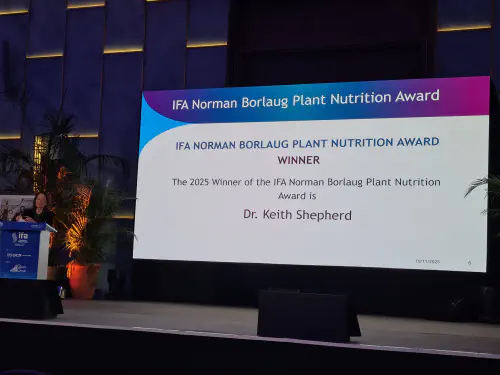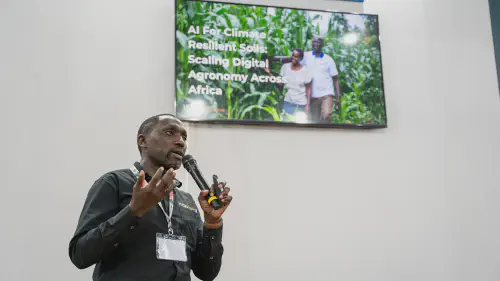In a world increasingly focused on artificial intelligence and digital solutions, Dr. Keith Shepherd has always been driven by one fundamental question: how can science truly serve farmers?
As iSDA’s Chief Scientist, Keith has spent decades building the tools and data systems that underpin modern agricultural decision-making in Africa. From co-leading the Africa Soil Information Service to pioneering the use of infrared spectroscopy for rapid, low-cost soil analysis, Keith’s work laid the foundation for iSDAsoil – Africa’s first high-resolution map of soil properties – now widely used by researchers, governments and farmers alike. But for Keith, data is only powerful when it leads to action.
We sat down with him to explore why science still matters – and how it’s powering Africa’s AI-driven agricultural future.
You’ve spent decades focused on soil health. In today’s AI-obsessed world, why does that still matter?
Soil is still the foundation. Without healthy soil, farmers can’t grow enough food, no matter how much technology they use. Poor soil fertility limits yields, increases the risk of poverty and food insecurity, and contributes to bigger problems: erosion, silting of dams, flooding, biodiversity loss and even migration and climate change through land clearance and greenhouse gas emissions.
AI can help, but it’s only as good as the data and science behind it. To make smart decisions – whether you’re a farmer applying nutrients, a company supplying fertiliser, or a government designing a subsidy scheme – you need solid, context-specific information. That’s where our soil science comes in.
Investments that helped transform farming in other continents – improving soils, boosting yields, reducing environmental damage – are urgently needed in Africa. But they need to be grounded in good science and tailored to the realities on the ground.
What’s been the biggest challenge in translating complex science into tools that actually help farmers?
Science alone doesn’t help if it’s not linked to real decisions. At iSDA, we always ask: What decisions does the farmer need to make today? What uncertainties are they facing? And what can we do to reduce those uncertainties and improve outcomes?
African farming systems are incredibly diverse – different soils, crops, histories, economic situations. Advice must be tailored to each farmer’s specific context. That’s not easy to scale. There aren’t enough extension officers to visit farmers regularly. And many were trained years ago, without access to the latest science.
That’s why our approach is “decision-first.” We’ve built systems that combine local farmer knowledge with deep scientific data, to make sure advice is not only accurate, but also actionable.
How did Virtual Agronomist come about – and what makes it different from traditional advisory tools?
The idea came from the increasing use of mobile phones in Africa. We saw an opportunity to deliver interactive, personalised advisory at scale. That became Virtual Agronomist.
It’s not just about broadcasting information – it’s about helping farmers think through key decisions. We ask about yields, management history and soil conditions. We use this to generate field-specific recommendations – like customised nutrient plans.
Unlike other tools, Virtual Agronomist is interactive and highly tailored. Our rule-based models combine farmer inputs with the latest scientific knowledge to offer the best possible advice for that plot, that crop, at that moment.
When AI chatbots like ChatGPT emerged in early 2023, we pivoted. We realised we could use AI not to give advice, but to improve communication – to hold the farmer’s hand throughout the season, much like a trusted extension officer would. We moved to WhatsApp, which most farmers already use, and introduced a lead farmer model to support those with limited smartphone access or literacy.
The results have been powerful – 1.5x yield increases on average, and several-fold when the advice is fully followed.
What role do funders, governments, or local organisations need to play in making this science work for farmers at scale?
Virtual Agronomist costs about $1 per farmer per season – extremely affordable. But it still needs to be seeded into communities. Once it is, we’ve seen it spread quickly.
To reach full potential, it needs to be paired with input supply, credit, insurance and marketing services. That’s where governments, funders and local organisations come in. We need partners who see the value of science-backed, farmer-first innovation and are ready to back tools that actually work on the ground.
What gives you hope about the future of African agriculture?
African farmers are incredibly resourceful and open to learning. What they’ve lacked is timely, relevant support. If we can provide the right advice, backed by good science and delivered through the tools they already use, they will thrive. That’s what gives me hope – and that’s what drives everything we do at iSDA.
iSDA’s Virtual Agronomist is built by scientists, proven on farms, and designed to scale. This is the AI engine of African agriculture – powered by deep science and driven by the needs of real farmers.
Latest Stories
Here’s what we've been up to recently.



